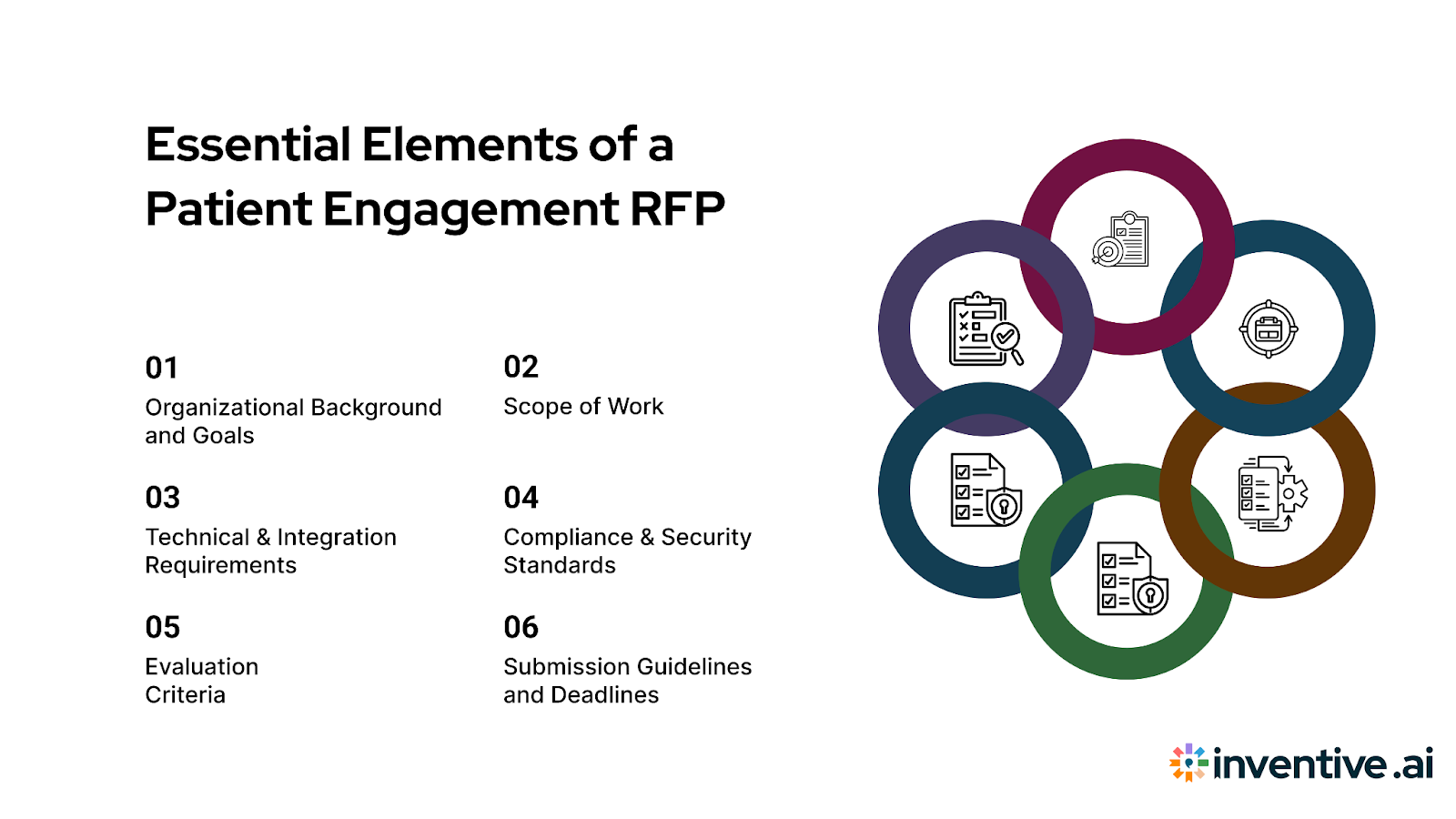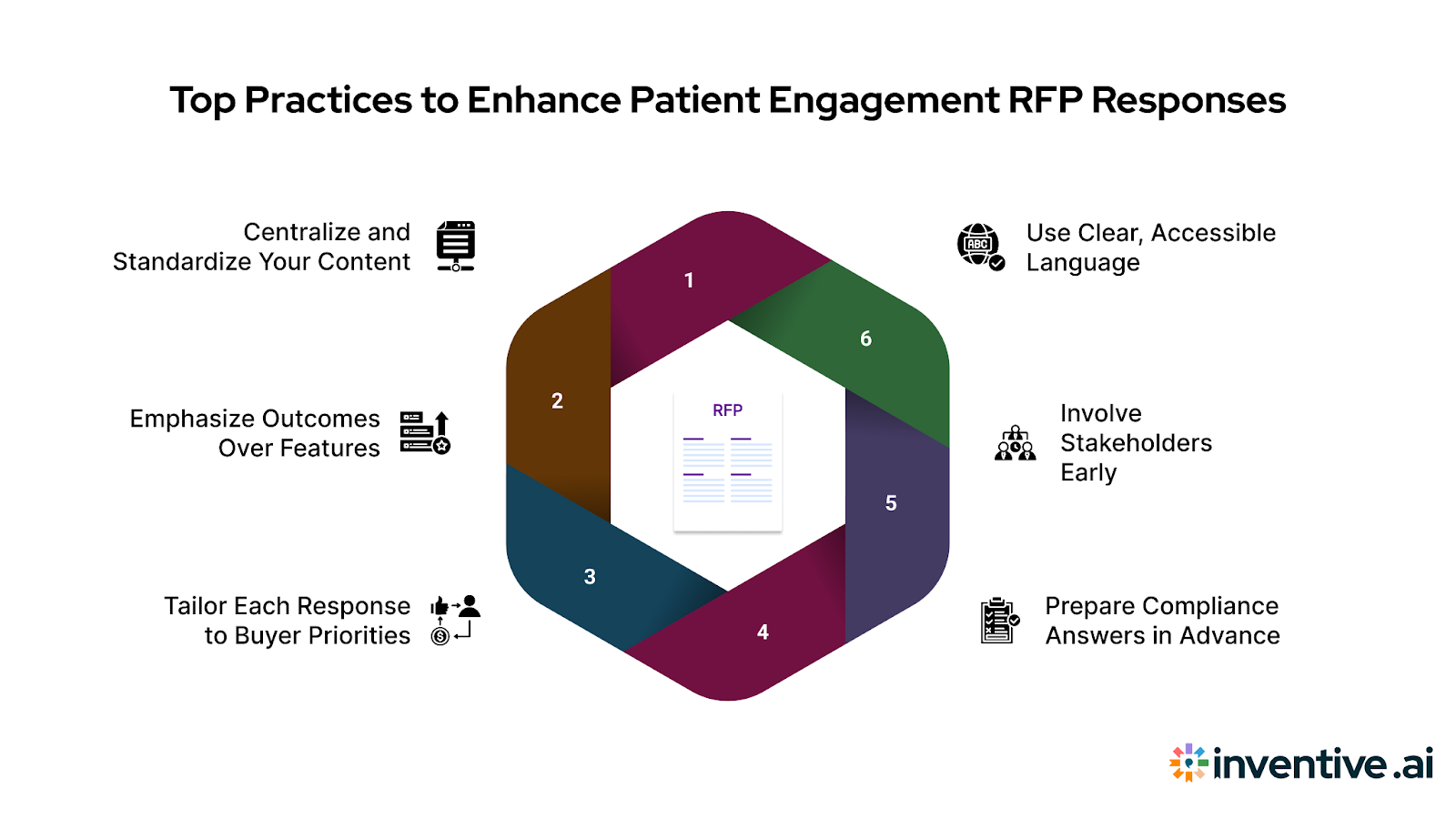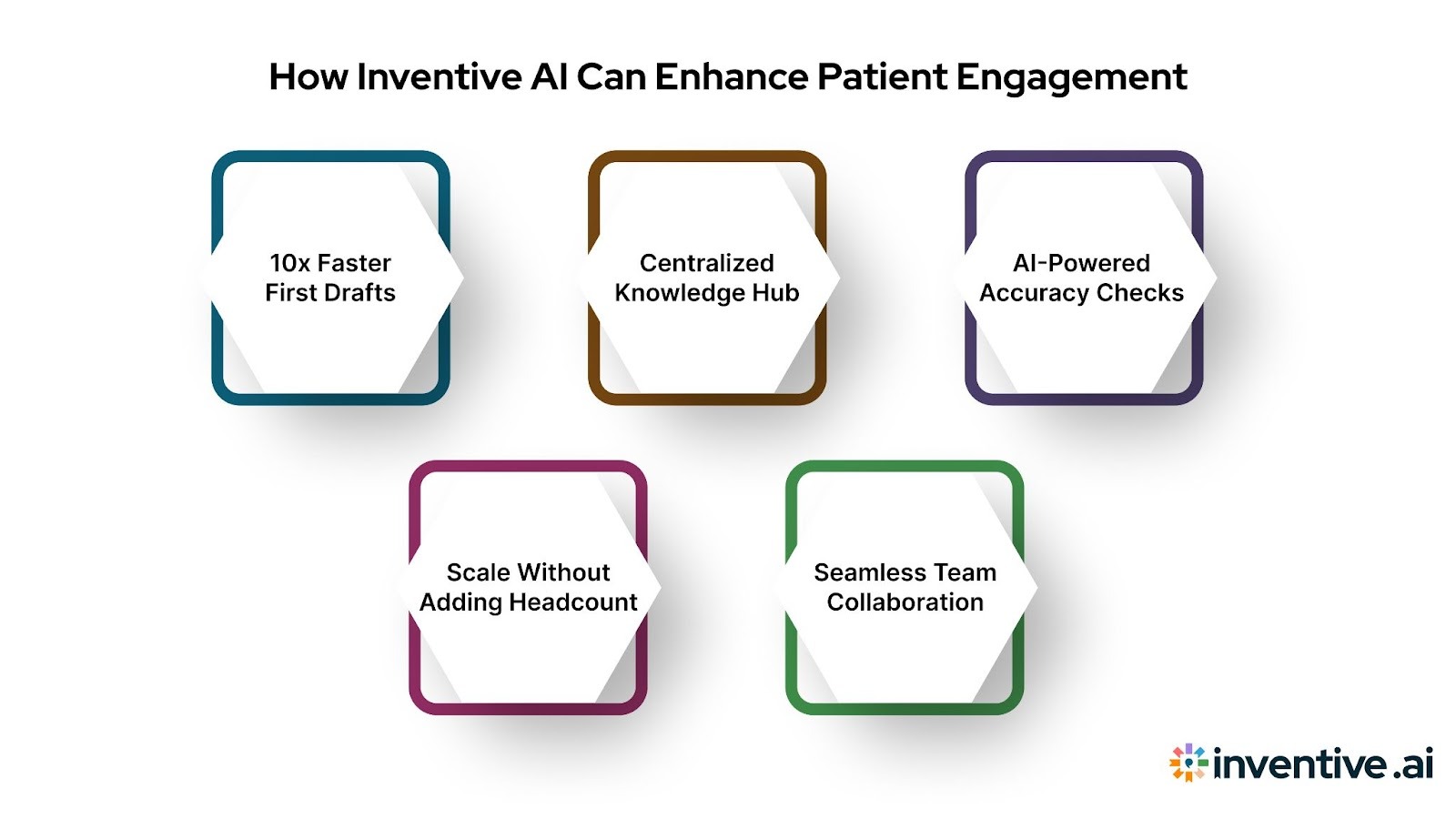Patient Engagement RFPs: How Healthcare Vendors Can Respond Faster and Win More Contracts?
In this blog, we’ll break down what patient engagement RFPs really are, what they typically include, the common mistakes vendors make, and how you can stand out with best practices.

Introduction
If you’ve been in healthcare sales long enough, you know the flood of RFPs never really stops. And lately, there’s a noticeable trend. More and more of them are tied to patient engagement research RFPs. Research shows that enterprise organizations spend around 38 hours writing proposals.
Hospitals, payers, and research organizations are under pressure to improve the patient experience, boost satisfaction scores, and prove measurable outcomes. That means vendors like you are constantly being asked to respond to detailed, compliance-heavy RFPs for patient portals, telehealth solutions, and engagement platforms.
In this blog, we’ll break down what patient engagement RFPs really are, what they typically include, the common mistakes vendors make, and how you can stand out with best practices. We’ll also look at how AI RFP automation can help healthcare vendors respond faster, more accurately, and win more contracts in this growing space.
Key Takeaways
- A patient engagement research RFP asks vendors for tech/services that improve patient interaction—portals, telehealth, trial recruitment, and population health tools.
- Heavy HIPAA/HITECH compliance, deep EHR/EMR integrations, short timelines, cross-team inputs, and pressure to prove outcomes (satisfaction, no-show reduction, trial enrollment).
- Org goals, scope, technical & integration needs, security/compliance, evaluation criteria (including patient outcome metrics), and strict submission rules.
- Centralize an updated knowledge hub, lead with measurable outcomes, tailor to buyer priorities, pre-approve compliance answers, involve SMEs early, and write clearly for mixed (clinical/IT) reviewers.
- Generate first drafts in minutes, keep compliance answers current, enable real-time collaboration, personalize at scale, and increase response capacity without extra headcount.
What are Patient Engagement RFPs?
A patient engagement RFP is a formal request issued by a healthcare provider, payer, or research organization looking for technology or services that improve how patients interact with their care.
These RFPs are common in areas like:
- Patient portals that let individuals access medical records, book appointments, and communicate with providers.
- Telehealth and virtual care platforms that extend care beyond the clinic.
- Clinical trial engagement tools are designed to recruit and retain participants more effectively.
- Population health and research solutions that focus on long-term patient outcomes.
Patient engagement RFPs are about more than just software. They reflect a broader shift in healthcare, one in which organizations must demonstrate their ability to empower patients, enhance satisfaction, and deliver measurable results. That’s why these RFPs often go beyond asking about features. They require vendors to demonstrate compliance with HIPAA and other regulations, explain integration capabilities with EHR/EMR systems, and show clear evidence of patient outcome improvements.
For vendors, this means the RFP isn’t just a checklist. It’s a chance to show how your solution directly impacts patients’ lives while meeting the rigorous standards healthcare organizations demand.
Knowing what these RFPs cover is only half the battle. The next step is understanding their key components.
Key Components of a Patient Engagement RFP
Patient engagement RFPs tend to follow a structured format, but the exact details vary depending on whether it’s a hospital, payer, or research organization issuing the request.
Still, most share a few standard components that vendors should be prepared to address:

Organizational Background and Goals
Buyers typically start by explaining who they are and what they want to achieve. For healthcare providers, that might be improving patient satisfaction scores or reducing no-show rates. For research organizations, it may be improving clinical trial recruitment and retention.
Scope of Work
This section lays out exactly what the organization expects from the vendor, whether it’s a patient portal, a telehealth platform, or a multi-channel engagement solution.
Technical and Integration Requirements
Healthcare RFPs almost always include detailed questions about how your solution integrates with existing EHR/EMR systems, security infrastructure, and third-party apps.
Compliance and Security Standards
From HIPAA in the U.S. to GDPR in Europe, compliance is non-negotiable. Many RFPs include an attached security questionnaire vendors must complete.
Evaluation Criteria
Buyers outline how they’ll judge proposals. This often includes cost, ease of implementation, vendor experience, compliance, and, increasingly, patient outcome metrics.
Submission Guidelines and Deadlines
Clear instructions on how to submit, formatting requirements, and timelines. Missing these details can result in disqualification, even if your solution is strong.
Understanding these components helps vendors organize their responses more effectively, anticipate the buyer’s priorities, and avoid last-minute scrambling for critical documents.
Even when vendors know what to expect, many still fall into common traps when responding.
Common Mistakes Vendors Make When Responding
Even strong healthcare vendors can lose out on patient engagement RFPs because of avoidable missteps.

Here are some of the most common mistakes, and how to steer clear of them:
Relying on Outdated Content
Many teams reuse old compliance answers or technical descriptions without checking for updates. The risk? Submitting incorrect HIPAA language or outdated integration details.
Solution: Maintain a centralized, regularly updated knowledge hub so every response reflects the most current information.
Focusing Too Much on Features, Not Outcomes
Vendors sometimes emphasize technical features while overlooking what buyers care about most: improved patient outcomes.
Solution: Frame responses around results in reduced no-shows, higher patient portal adoption, faster trial enrollment, backed by data.
Ignoring Formatting or Submission Rules
Missing a file format requirement or failing to follow submission instructions can disqualify a proposal, no matter how strong the content is.
Solution: Assign one team member to review all submission guidelines and perform a final compliance check before sending.
Last-Minute Collaboration
Waiting until the end to pull inputs from IT, compliance, and sales teams creates rushed, error-prone proposals.
Solution: Involve stakeholders early and use collaborative platforms to streamline input collection.
Generic Responses That Fail to Stand Out
Buyers can spot boilerplate language instantly. A generic response signals that the vendor doesn’t understand the organization’s unique needs.
Solution: Personalize each response by aligning it with the buyer’s stated goals and priorities.
By avoiding these pitfalls, vendors not only increase their chances of winning but also build trust with buyers who want to see accuracy, clarity, and a focus on outcomes.
These mistakes are often symptoms of deeper challenges that make healthcare RFPs especially difficult to manage.
Why Responding to Patient Engagement RFPs is Challenging for Vendors?
Responding to any RFP takes time, but patient engagement RFPs come with unique challenges that make the process even more demanding. For healthcare vendors, these hurdles can quickly turn into lost opportunities if not managed well.

High Compliance Burden
Every response must meet strict regulations like HIPAA, HITECH, and, in some cases, GDPR. Crafting accurate, compliant answers is time-intensive and requires input from legal and compliance teams.
Complex Technical Requirements
Buyers expect vendors to explain how their solutions integrate with existing EHR/EMR systems, scheduling tools, and telehealth platforms. Vendors must balance technical depth with clarity to make sure responses are understandable to non-technical evaluators.
Cross-Department Coordination
Patient engagement RFPs touch multiple teams such as sales, IT, compliance, product, and clinical experts. Getting consistent input from all of them under a tight deadline can slow down the process.
Short Turnaround Times
Healthcare RFP deadlines are often aggressive, leaving little room for back-and-forth. Vendors may spend over 25–30 hours per RFP, only to rush at the end and compromise on quality.
Pressure to Prove Outcomes
Buyers want more than technical details; they want evidence that a solution can improve patient satisfaction, increase portal usage, or drive clinical trial recruitment. Many vendors struggle to present this data in a convincing manner.
These challenges explain why many vendors feel stretched thin when responding to patient engagement RFPs. Without the right systems and automation, the process drains resources and reduces the chances of winning contracts.
The good news?
There are proven practices vendors can follow to overcome these challenges and stand out.
Best Practices to Improve Patient Engagement RFP Responses
Winning patient engagement RFPs is about showing buyers that your solution is the best fit for their goals.

Here are some proven practices to strengthen your responses:
1. Centralize and Standardize Your Content
What to do: Create a knowledge hub that stores up-to-date compliance language, technical details, and case studies.
Why it helps: Instead of scrambling for documents at the last minute, your team can quickly pull accurate, approved content into every proposal.
2. Emphasize Outcomes Over Features
What to do: Highlight measurable results like reduced no-show rates, improved patient portal adoption, or faster clinical trial recruitment.
Why it helps: Buyers want proof that your solution improves patient outcomes, not just a list of technical capabilities.
3. Tailor Each Response to Buyer Priorities
What to do: Customize proposals by aligning with the goals stated in the RFP (e.g., patient satisfaction, engagement analytics, or compliance).
Why it helps: Personalization shows you’ve listened and understood the organization’s needs, making your response stand out.
4. Prepare Compliance Answers in Advance
What to do: Build a library of boilerplate responses for HIPAA, HITECH, and data security questions.
Why it helps: Saves time and ensures consistency across proposals while reducing the risk of compliance errors.
5. Involve Stakeholders Early
What to do: Engage IT, compliance, and clinical teams at the start of the process instead of waiting until the final draft.
Why it helps: Early collaboration minimizes last-minute changes and ensures technical and compliance accuracy.
6. Use Clear, Accessible Language
What to do: Avoid jargon when describing integrations or patient engagement outcomes. Write so both technical and non-technical evaluators can understand.
Why it helps: Healthcare RFP review teams are often cross-functional; clarity ensures everyone understands your value.
By applying these best practices, vendors can transform RFP responses from rushed submissions into strategic documents that effectively highlight their expertise, compliance readiness, and potential patient impact.
Still, even with best practices, manual processes can only take you so far. But then you would need AI automation.
How AI RFP Automation Helps Healthcare Vendors Win Patient Engagement Deals?
Responding to patient engagement RFPs can be overwhelming, with vendors juggling compliance requirements, technical details, and strict deadlines. AI RFP automation simplifies the process by eliminating repetitive work and reducing the risk of errors, allowing teams to focus on strategy and outcomes.
Faster First Drafts
AI systems can generate initial responses by pulling from past proposals, compliance libraries, and technical documents.
Benefit: Cuts down hours of manual drafting so teams can refine responses instead of starting from scratch.
Built-In Compliance Accuracy
Automated tools flag outdated or incomplete answers for HIPAA, HITECH, or security requirements.
Benefit: Ensures every response stays accurate and compliant, reducing the chance of disqualification.
Smarter Collaboration
Centralized platforms allow sales, IT, compliance, and clinical teams to work from the same set of documents.
Benefit: Eliminates version-control issues and last-minute bottlenecks.
Personalization at Scale
AI tools can analyze RFP requirements and highlight buyer-specific priorities such as patient satisfaction or clinical trial engagement.
Benefit: Helps vendors show alignment with buyer goals, making proposals more compelling.
Higher Response Capacity
By automating repetitive tasks, vendors can handle more RFPs without overloading their teams.
Benefit: Increases opportunities to win new contracts while maintaining quality.
Let us consider an example. A digital health vendor receives an RFP to support clinical trial recruitment with patient engagement tools. Normally, they’d spend weeks consolidating compliance answers, technical integration notes, and case studies.
With automation, the first draft is ready within hours, compliance responses are pulled from a verified library, and the proposal highlights proven metrics on patient enrollment and retention. Instead of racing against the clock, the team submits a confident, outcome-focused proposal and stands out from competitors.
How can Inventive AI Help With Patient Engagement?
Healthcare vendors face some of the toughest RFPs in the market. Patient engagement proposals often require HIPAA compliance, detailed EHR/EMR integration information, and evidence of improved patient outcomes.
Without the right tools, proposal teams spend hours reformatting responses, verifying compliance language, and chasing inputs across IT, clinical, and sales teams. The result? Slower submissions, inconsistent responses, and lost opportunities.

Inventive AI is built to solve these challenges by delivering AI-powered automation tailored to the needs of healthcare vendors.
10x Faster First Drafts
Inventive AI generates complete first drafts in minutes using your approved knowledge base, compliance libraries, and past healthcare proposals. Instead of starting from scratch, teams can focus on refining responses that emphasize patient outcomes and ROI.
Centralized Knowledge Hub
Say goodbye to scattered documents across emails, spreadsheets, and shared drives. With Inventive AI, all security certifications, HIPAA responses, technical integration details, and case studies are stored in one place, always accurate and up to date.
AI-Powered Accuracy and Compliance Checks
The platform automatically detects outdated HIPAA responses, missing certifications, or conflicting technical information. This ensures every submission meets strict buyer standards and maintains professional credibility.
Scale Without Adding Headcount
By automating repetitive drafting and formatting, Inventive AI enables vendors to respond to up to 3x more patient engagement RFPs without overloading sales, IT, or compliance teams.
Seamless Team Collaboration
Healthcare RFPs require cross-departmental inputs. With integrations into Slack and Microsoft Teams, Inventive AI streamlines collaboration by assigning tasks, tracking approvals, and keeping proposals on schedule without endless back-and-forth emails.
Here’s why it matters for healthcare vendors:
- Respond to more patient engagement RFPs without exhausting your teams.
- Deliver consistent, compliance-ready answers across all proposals.
- Strengthen buyer confidence by eliminating outdated or conflicting information.
- Free your teams to focus on strategy, differentiation, and highlighting patient outcomes.
With Inventive AI, healthcare vendors can transform patient engagement RFPs from a time-consuming burden into a streamlined, automated process that accelerates submissions, improves accuracy, and drives higher win rates.
Conclusion
Patient engagement RFPs are strategic opportunities for healthcare vendors to showcase expertise, compliance readiness, and measurable patient outcomes. Yet, manual processes make it difficult to respond quickly, maintain accuracy, and differentiate oneself in a competitive market.
By adopting more innovative practices and leveraging AI-driven automation, vendors can reduce response times, enhance proposal quality, and manage a higher volume of RFPs without overburdening their teams. The result is not just faster submissions, but stronger proposals that resonate with buyers and increase win rates.
FAQs
1. What is a patient engagement research RFP?
A patient engagement research RFP is a formal request issued by healthcare providers, payers, or research organizations seeking vendors who can provide technology or services to improve patient interaction, such as portals, telehealth platforms, or trial engagement tools.
2. Why are patient engagement RFPs important for healthcare vendors?
They represent opportunities to secure high-value contracts in a growing market. Winning these RFPs enables vendors to expand their footprint, showcase their compliance readiness, and demonstrate measurable improvements in patient outcomes.
3. How long does it typically take to respond to a patient engagement RFP?
On average, healthcare RFP responses can take 25–30 hours or more due to compliance-heavy requirements, cross-department inputs, and detailed technical integration details.
4. What makes patient engagement RFPs different from other healthcare RFPs?
They emphasize not just technical capabilities but also evidence of improved patient satisfaction, reduced no-shows, enhanced clinical trial recruitment, and compliance with stringent data regulations, such as HIPAA.
5. How can automation improve patient engagement RFP responses?
Automation helps vendors generate faster first drafts, ensure compliance accuracy, centralize content, and personalize proposals at scale, enabling them to handle more RFPs and improve win rates.


